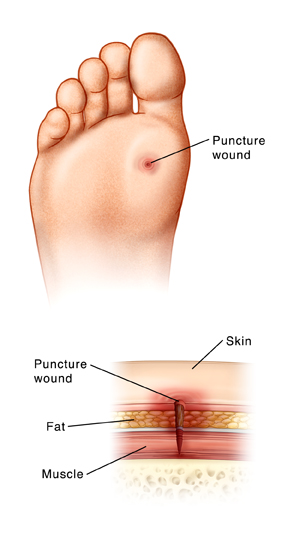A puncture wound occurs when a pointed object (such as a nail) pushes into the skin. It may go into the tissues below the skin of the foot, including fat, muscle, and even bone. This type of wound is narrow and deep. It can be hard to clean. Puncture wounds are at high risk for becoming infected. One type of serious infection is more likely if you were wearing a rubber-soled shoe at the time of injury. Bacteria from the sole of the shoe may be dragged into the wound and cause a hard to treat bone infection called osteomyelitis. Symptoms of infection may appear as late as 2 to 3 weeks after the injury. Watch for symptoms of infection and call your doctor right away if any of them appear.
X-rays may be done to see if any objects are still under the skin. You may also need a tetanus shot. This is given if you're not up-to-date on this vaccine.
Puncture wounds can easily become infected.
Home care
-
When you sit or lie down, raise the foot above the level of your heart. This helps reduce swelling and pain.
-
Don't put weight on the injured foot if it hurts to do so, or if you were told to keep weight off the injury.
-
Your doctor may prescribe an antibiotic. This is to help prevent infection. Follow all instructions for taking this medicine. Take the medicine every day for as long as the doctor advises.
-
Take acetaminophen or ibuprofen for pain, unless your doctor prescribes a different medicine for pain. Follow all instructions for taking pain medicines.
-
Follow the doctor's instructions on how to care for the wound.
-
Keep the wound clean and dry. Don't get the wound wet until you are told it's okay to do so. If the area gets wet, gently pat it dry with a clean cloth. Replace the wet bandage with a dry one.
-
If a bandage was applied and it becomes wet or dirty, replace it. Otherwise, leave it in place for the first 24 hours.
-
Once you can get the wound wet, shower as normal. But don't soak the wound in water (no tub baths or swimming).
-
Check the wound daily for symptoms of infection. These include:
-
Increasing redness or swelling around the wound.
-
Increased warmth of the wound.
-
Pain that gets worse.
-
Red streaking lines away from the wound.
-
Draining pus.
-
Follow-up care
Follow up with your doctor, or as advised.
When to get medical care
Call your doctor right away if you have:
-
Any symptoms of infection (listed above).
-
A fever of 100.4°F (38.ºC) or higher, or as advised by your doctor.
-
Wound changes colors.
-
Numbness around the wound.
-
Decreased movement around the injured area.


